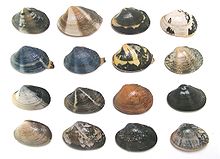Venerupis philippinarum
| Venerupis philippinarum | |
|---|---|
 |
|
| Scientific classification | |
| Kingdom: | Animalia |
| Phylum: | Mollusca |
| Class: | Bivalvia |
| Order: | Veneroida |
| Family: | Veneridae |
| Genus: | Venerupis |
| Species: | V. philippinarum |
| Binomial name | |
|
Venerupis philippinarum (A. Adams & Reeve, 1850) |
|
| Synonyms | |
|
Tapes philippinarum |
|
Tapes philippinarum
Ruditapes philippinarum
Venus philippinarum
Tapes japonica
Tapes semidecussata
Paphia bifurcata
Tapes quadriradiatus
Tapes violascens
Venerupis philippinarum is an edible species of saltwater clam, a marine bivalve mollusk in the family Veneridae, the Venus clams.
The common names of the species include "Asari" (after its Japanese name), "Japanese littleneck", "Manila clam", "steamer clam", "Filipino Venus", "Japanese cockle", and "Japanese carpet shell".
The shell of Venerupis philippinarum is elongate, oval, and sculptured with radiating ribs (Morris, 1980). It grows to 7.5 cm (3.0 in) across and 3.5 cm (1.4 in) in width. The color is highly variable: it is commonly grayish, greenish, brownish, yellow or buff with distinct dark or light colored, with triangular mottled markings that begin at the umbo and disperse outwards. The true color can be distorted by dark gray staining, caused by anoxic mud. The foot of live specimens is an orange color.
The features most diagnostic for the identification of this species are the following: that the inner ventral margin of the shell is smooth; the ligament is prominent and elevated above the dorsal margin. In the living animal, the siphons are separated at the tips (Carlton, 2007). Water is drawn in and out of a clam by siphons that protrude from the posterior end of the shell. In this species, the siphons are mostly fused, and are only separate at the tips. The siphons are short relative to some other clams, which means that the clam lives burrowed only a shallow distance under the surface of the substrate. Short siphons are what inspire the common name “littleneck clam”.
In western North America, this species is often confused with Protothaca staminea, however, V. philippinarum shells are more elongate than P. staminea. Internally, V. philippinarum has yellowish valves, with a purple suffusion near the posterior margin. Protothaca staminea lacks this purple suffusion. This species may be found together with Protothaca staminea, but tends to reside at slightly higher tide levels.
...
Wikipedia
